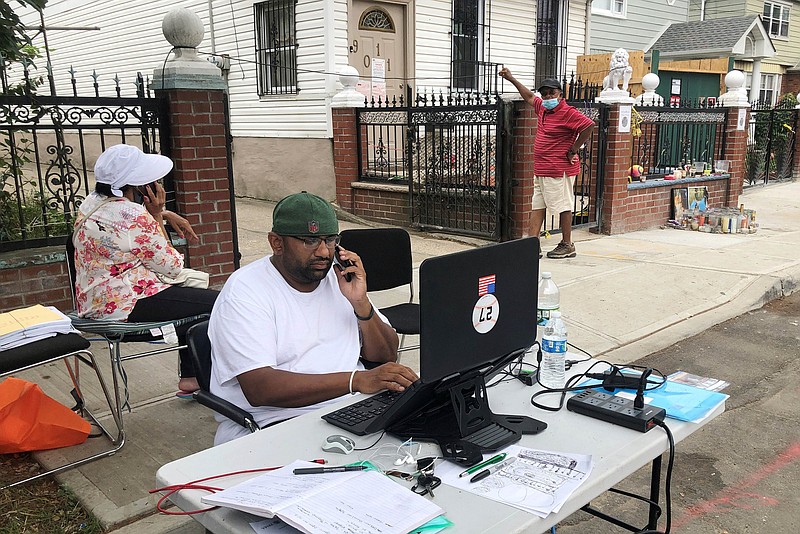NEW YORK -- After being pummeled by two tropical storms that submerged basements, cracked home foundations and destroyed belongings, Northeastern U.S. residents still in the throes of recovery are being hit with another unexpected blow: Thousands of families are now swamped with financial losses because they didn't have flood insurance.
Most of those caught off guard by the intense downpours from the remnants of Hurricane Ida and Tropical Storm Henri lived in areas outside of coastal floodplains, making flood insurance an afterthought for most of the working-class families whose neighborhoods were among the hardest hit.
"When we called the insurance company, the first thing they told us is that they don't provide any assistance for anything that's caused by a storm. And they left it at that," Amit Shivprasad said, his rising voice echoing frustrations shared among his neighbors in the Jamaica section of Queens.
For weeks now, Shivprasad and his parents have been crammed into a relative's apartment after New York City building inspectors declared their home uninhabitable.
Floodwaters from Ida, exacerbated by overflowing storm and sewer drains, ripped through an exterior wall and drowned two of the family's tenants in a basement apartment. The storm killed about 50 people across the Northeast, many of whom drowned in basement apartments or in cars. It lashed the region less than two weeks after a drenching from Henri.
Among the roughly 10,000 homes in Shivprasad's neighborhood, just 16 were protected by flood insurance, according to a database compiled by the Association of State Floodplain Managers.
Flood damage is not covered by homeowners or renters insurance policies. People without flood policies have few options for getting help paying for damage, according to Loretta Worters, a spokeswoman for the Insurance Information Institute. They may be able to get federal assistance, she said, including low-interest loans and grants for the damage.
While officials are still calculating the losses -- believed to be in the billions of dollars -- residents wonder how they'll come up with the money to repair homes and replace belongings. Fans continue to whir in dank basements, and dump trucks still make the rounds to haul away mildewed couches, squishy mattresses and now-useless electronics.
The Federal Emergency Management Agency said it has already disbursed at least $22 million to nearly 5,200 families in New York City. More than 38,000 households have applied for aid. In New Jersey, assistance to some 39,000 families is still pending, while FEMA has paid out about $11 million to nearly 3,000 families.
Thus far, about $10 million in flood insurance claims has been paid out in New Jersey to 6,000 policy holders, according to FEMA. In New York City's five boroughs, about $3 million has been disbursed for 2,600 flood insurance claims.
Flood insurance, offered through the National Flood Insurance Program, is generally required for mortgages on properties considered to have a roughly 1 in 100 chance each year of flooding -- but is optional for everyone else. Some see it as an unnecessary cost, even as severe weather now strikes with more frequency and greater intensity.
"You never know, particularly with the way the world is acting right now, when that flood is going to occur in your neighborhood," said Michael Wade, a FEMA spokesman.
John and Roseann Kiernan's neighborhood in Rossmoor, a senior living development in Monroe Township in central New Jersey, is 20 miles from the coastline and not near any major rivers. The Kiernans and others said they were told over the years that they didn't need flood insurance because the area isn't in a flood zone -- even though the neighborhood flooded in 2005.
The Kiernans estimate that it will cost $100,000 to get their house back to a livable condition and replace their car.
Their existing policy "covered nothing," said John Kiernan, a retired corrections officer. "The insurance company sent out some very nice, understanding people, they listened to everybody for an hour or so, then basically said, 'You're not getting anything.' So that's the way it is."
Around the corner from the Kiernans, Joan Russo and her husband have lived in the same house for 16 years and moved in a few days before the flooding in 2005. Their house suffered extensive water damage during Henri, forcing them to move in with her son's family in another town.
"When we were getting our insurance, they said, 'You're not in a flood area, there's no need for that,'" she said. "You listen to the supplier, and they say you don't need it, so you don't get it."
Information for this article was contributed by Ken Sweet of The Associated Press.
